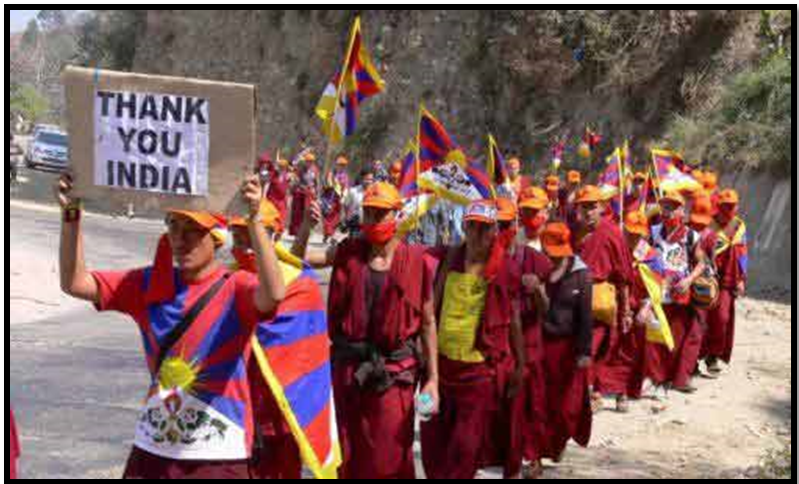THE TIBETAN QUANDARY: STATELESSNESS, IDENTITY, AND THE STRUGGLE FOR CITIZENSHIP IN INDIA
Syllabus:
- GS-3- Refugees in India, Chinese aggression , India’s adherence to global rules and regulations
Focus :
- The article addresses the complex legal status of Tibetan refugees in India, highlighting the challenges of statelessness, the bureaucratic hurdles in obtaining necessary documentation, and the socio-political implications of their uncertain future. It underscores the need for comprehensive policies and international cooperation to support the Tibetan community.
Source - TH
Introduction
- Over 60 years since their arrival in India, Tibetans face an unresolved status amidst complex legal and political landscapes.
- The influx began in 1959 following the Dalai Lama’s flight from Chinese occupation.
- Despite asylum and temporary settlement assistance, the Tibetan community’s future remains uncertain due to India’s citizenship laws and its non-participation in the 1951 United Nations Convention on Refugees.
The Initial Exodus and Settlement
- 1959 Influx: Thousands of Tibetans arrived in India as refugees alongside the Dalai Lama.
- Government Response: India provided asylum and assistance for temporary settlements.
- Current Status: The Tibetan community now includes third-generation settlers, but their status remains ambiguous.
Legal and Bureaucratic Hurdles
- Registration Certificates (RCs): Required for Tibetans to live in India, as per the Foreigners Registration Act, 1946, and the Registration of Foreigners Rule.
- Travel Documents: Identity Certificates (IC) and Special Entry Permits (SEP) are needed for traveling abroad and re-entering from Nepal.
- Online Renewal: In 2016, the Ministry of Home Affairs (MHA) made RC renewal online and extended the renewal period to five years.
Demographic Shifts and Migration Trends
- Population Decline: From 1.10 lakh in 2009 to 73,404 in 2019, as per the MHA’s 2022-23 Annual Report.
- Migration Abroad: Significant migration of Tibetans to other countries due to various socio-economic reasons.
- Geographical Distribution: Major concentrations in Karnataka (21,324), Himachal Pradesh (14,952), Arunachal Pradesh (4,780), Uttarakhand (4,829), West Bengal (3,076), and Ladakh (6,989).
Government Policies and Support
- Tibetan Rehabilitation Policy: Formulated by the MHA in consultation with the Dalai Lama’s Central Tibetan Relief Committee (CTRC) to address community issues.
- Financial Aid: In 2015, the NDA government sanctioned a grant-in-aid scheme of ₹40 crore to CTRC for five years, later extended for another five years.
Challenges Facing the Tibetan Community
- Uncertain Future: Young Tibetans are concerned about their future, especially post the Dalai Lama.
- Community Shrinkage: Emigration and demographic decline have shrunk the Tibetan community in India.
- Internal Divisions: The Tibetan Parliament (in-exile) has shown a lack of unity, exacerbating community concerns.
Issues with Travel Documentation
- Slow Processes: Obtaining ICs has become increasingly difficult, with delays ranging from one to three years.
- Impact on Opportunities: These delays severely affect Tibetans’ ability to plan international travel for education or other purposes.
Citizenship and Legal Rights
- Foreigners in India: Tibetans are recognized as foreigners, restricting their ability to buy property and access certain rights.
- Citizenship Act, 1955: States that those born in India between January 26, 1950, and July 1, 1987, are citizens by birth, but few Tibetans have obtained citizenship through the courts.
- Passport Guidelines: In 2018, the Ministry of External Affairs issued guidelines for issuing passports to Tibetan refugees, subject to police verification.
Social and Cultural Dimensions
- Cultural Identity: The lack of educational materials about the Tibetan movement contributes to a lack of awareness and recognition of their plight.
- Political Recognition: Despite gratitude for India’s support, Tibetans are aware that India recognizes Tibet as part of China, complicating their political stance.
Reflections from the Tibetan Community
- Activist Perspectives: Tibetan activist and poet Tenzin Tsundue highlights the difficulties of acquiring Indian citizenship and the implications for community cohesion and parental connections.
- Future Concerns: The community’s reliance on the Dalai Lama for hope and the potential consequences of his absence are significant concerns.
Conclusion
- Need for Comprehensive Solutions: There is an urgent need for policies that address the legal, social, and economic challenges faced by Tibetans in India.
- Government and Community Cooperation: Enhanced cooperation between the Indian government and the Tibetan community is essential to ensure a sustainable and secure future for Tibetan refugees.
Source:The Hindu
Associated Article :
https://universalinstitutions.com/world-development-report-2023-migrants-refugees-and-societies/
Mains Practice Question :
GS-3
- “Examine the legal and socio-economic challenges faced by Tibetan refugees in India. Discuss the measures that can be undertaken to address their statelessness and ensure their integration into Indian society.”(250 words)






